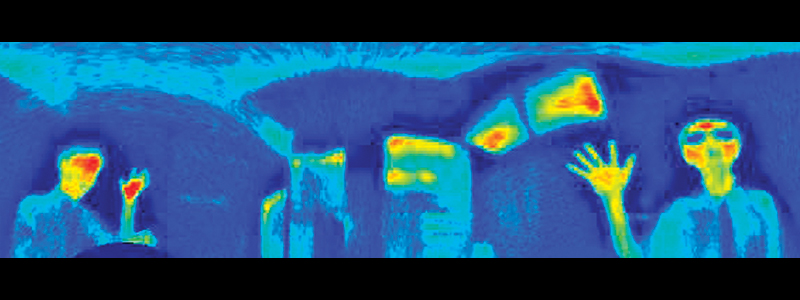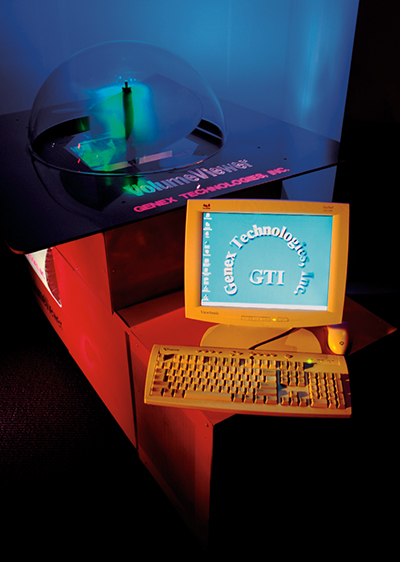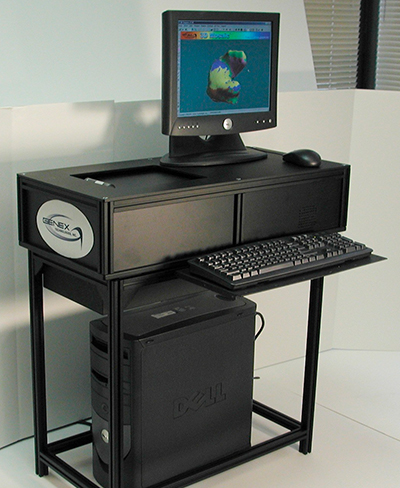
Speaking Volumes About 3-D
Genex Technologies, Inc., of Kensington, Maryland, has joined forces with NASA to develop a volumetric display system that does more than just capture a "moment." The state-of-the-art technology is capable of depicting the true, three-dimensional (3-D) essence of the world, unlike most existing cameras and electronic image displays that are limited to portraying two-dimensional (2-D), flat images that lack physical depth cues.
In 1999, Genex submitted a proposal to NASA's Stennis Space Center for a volumetric 3-D display technique that would provide multiple users with a 360-degree perspective to simultaneously view and analyze 3-D data. Genex, which has specialized in 3-D imaging and viewing since 1995, claimed that such a technique could significantly enhance the efficiency and accuracy of decision-making and validation. That same year, Stennis awarded Genex with a Small Business Innovation Research (SBIR) contract to develop the prototype version of the technology, now known as the VolumeViewer,® to enable the real-time processing and visualization of 3-D data collected by the Space Center. Currently, the VolumeViewer allows NASA to better analyze and assess the various data collected by its satellite and spacecraft sensors, such as hyper-spectral data sets, multi-variants geospatial data, and remote sensor data.
Unlike hologram technologies, the VolumeViewer is not an illusion. The system's true image capabilities stem from a Genex-developed technique that uses laser-light projection and a rotating "vortex" display screen to actually create a "viewing box." The VolumeViewer displays nearly 34 million "voxels" (i.e., x, y, and z points, analogous to pixels in a 2-D image) of data, enabling a user to view a complex 3-D shape or image from multiple perspectives, without the need for special viewing aids or goggles. This 3-D display system provides both physiological and psychological depth cues required by the human visual system to perceive 3-D objects, literally adding a new dimension to the dynamic interaction between mankind and the surrounding world. Furthermore, Genex notes that the unique, walk-around viewing perspective and the direct interaction with the system's "fish tank-like" volumetric images could greatly simplify human understanding of the intricacies of 3-D objects and the spatial relationships among them.
The futuristic capabilities of the VolumeViewer have offered tremendous benefits to commercial users in the fields of medicine and surgery, air traffic control, pilot training and education, computer-aided design/manufacturing, and military/battlefield management. Possible future applications include 3-D television, video games, sport stadium displays, and homeland defense.
Genex capitalized on its success with Stennis by introducing two separate products to the commercial market that incorporate key elements of the 3-D display technology designed under the SBIR contract. The company's patented Rainbow 3D® imaging camera is a novel, three-dimensional surface profile measurement system that can obtain a full-frame 3-D image in less than 1 second. The technology is based on a structured-light process that projects random colors on a given surface and captures over 440,000 data points of information. The resulting data model represents voxels for every visible point on the object surface, displayed in a single 3-D image. Because the camera uses white-light technology rather than lasers, it is ideal for medical and research applications, where eye safety can be a major concern. Such applications include oncology and radiology, as a positioning device to precisely align patients during sensitive radiation treatments, and pre- and post-surgery analyses, to provide quantitative 3-D measurements. The technology is especially practicable for commercial manufacturing applications involving rapid prototyping and reverse engineering, due to its speed and cost-effectiveness.
Other applications include dentistry and orthodontics, plastic/cosmetic surgery, prostheses design, artifact archiving, and mass customization of products. The most recent application of the technology involves 3-D facial recognition, dramatically enhancing the performance of traditional 2-D systems by addressing issues related to facial orientation and lighting/shadow effects. Genex also offers add-on software packages that allow users to perform customized post-processing functions, including image registration, editing, manipulation, and measurement calculations.
The third product to evolve from Genex's work with Stennis is the patented 360-degree OmniEye® video system. Ideal for intrusion detection, surveillance, and situation management, this unique camera system offers a continuous, panoramic view of a scene in real-time. In contrast to ordinary cameras that have relatively small viewing angles, the OmniEye's 360-degree, motion-capturing technology eliminates potential blind spots. Additionally, a single OmniEye unit can survey an area that previously required multiple cameras. Applications include banks, casinos, retail shops, airports, and industrial settings.
Genex recently introduced the OmniEye Infrared™ model for perimeter control, motion detection, and area surveillance in complete darkness and low-light environments. This camera offers unobtrusive monitoring for military and covert operations, and is used to uphold public safety measures and deter criminal activity.
In June of 2001, the company continued its working relationship with Stennis in an effort to further expand its knowledge of the third dimension. Given its recent track record, Genex may be on its way to opening a portal to a whole new dimension of commercial technology.
VolumeViewer,® Rainbow 3D,® and OmniEye® are registered trademarks of Genex Technologies, Inc.
OmniEye Infrared™ and EI Digitizer™ are trademarks of Genex Technologies, Inc.

The VolumeViewer® true 3-D display system provides both physiological and psychological depth cues required by the human visual system to perceive 3-D objects.

The EI (Ear Impression) Digitizer™ integrates Genex’s patented Rainbow 3D® camera technology to quickly and accurately capture and build a full 360-degree 3-D model in an automated process. The final model of the ear impression can then be used to streamline the process of creating a custom-fitting hearing aid.

The OmniEye Infrared™ marries the full functionality of panoramic video with the latest thermal infrared technology to enable 360-degree viewing and motion detection in complete darkness.













